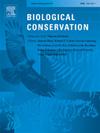Identifying complementary conservation and restoration priority areas for plant species
IF 4.9
1区 环境科学与生态学
Q1 BIODIVERSITY CONSERVATION
引用次数: 0
Abstract
The coverage of protected areas (PAs) remains far from the Kunming-Montreal target and degraded ecosystems are greatly limiting the conservation efficiency of PAs. Therefore, this paper proposes a method to identify conservation and restoration priority areas to supplement existing PAs. A case study was conducted focusing on Yunnan, southwestern China, which intersects with three world biodiversity hotspots. First, the spatial ranges for 3768 representative conservation plant species were mapped using species distribution models. Subsequently, planning units were classified into three restorability categories, namely no-need restoration, potentially restorable and non-restorable units, according to land cover changes between 2000 and 2020. Then, conservation and restoration priority areas were identified by applying a two-step systematic conservation planning process. Finally, replacement cost analysis was applied to compare the effectiveness of existing PAs and the overall 30 % priority areas. Northwestern, southwestern, and southeastern Yunnan have high biodiversity conservation values. Especially in eastern and southeastern Yunnan, large amounts of restoration priority areas were identified. Conservation and restoration priority areas account for 15.80 % and 3.69 % of Yunnan's land, respectively. Compared to existing PAs, conservation priority areas can increase the number of species covered from 2461 to 3277, and further to 3566 when including restoration priority areas. Compared to existing PAs, the mean species coverage in the overall 30 % priority areas has increased from 27.28 % to 72.69 %. Notably, 12.86 % of existing PAs were identified as restoration priority areas. This study indicates that in addition to conservation measures, implementing restoration strategies in high conservation-value areas is equally important.
确定植物物种的补充保护和恢复优先区域
保护区(PAs)的覆盖范围与昆明-蒙特利尔的目标仍相差甚远,退化的生态系统极大地限制了保护区的保护效率。因此,本文提出了一种确定保护和恢复优先区域的方法,以补充现有的保护区。本文以中国西南部与世界三大生物多样性热点地区交汇的云南为重点开展了案例研究。首先,利用物种分布模型绘制了 3768 种代表性保护植物的空间分布范围。随后,根据 2000 年至 2020 年的土地覆被变化,将规划单元划分为三个可恢复性类别,即无需恢复、潜在可恢复和不可恢复单元。然后,采用两步系统保护规划流程确定保护和恢复优先区域。最后,采用重置成本分析法比较现有保护区和总体 30% 优先区域的有效性。云南西北部、西南部和东南部具有较高的生物多样性保护价值。特别是在云南东部和东南部,确定了大量的恢复优先区域。保护优先区和恢复优先区分别占云南土地面积的 15.80% 和 3.69%。与现有保护区相比,保护优先区可覆盖的物种数量从 2461 种增加到 3277 种,如果包括恢复优先区,则可进一步增加到 3566 种。与现有保护区相比,总体 30% 优先区域的平均物种覆盖率从 27.28% 增加到 72.69%。值得注意的是,12.86% 的现有保护区被确定为恢复优先区域。这项研究表明,除保护措施外,在高保护价值地区实施恢复战略也同样重要。
本文章由计算机程序翻译,如有差异,请以英文原文为准。
求助全文
约1分钟内获得全文
求助全文
来源期刊

Biological Conservation
环境科学-环境科学
CiteScore
10.20
自引率
3.40%
发文量
295
审稿时长
61 days
期刊介绍:
Biological Conservation is an international leading journal in the discipline of conservation biology. The journal publishes articles spanning a diverse range of fields that contribute to the biological, sociological, and economic dimensions of conservation and natural resource management. The primary aim of Biological Conservation is the publication of high-quality papers that advance the science and practice of conservation, or which demonstrate the application of conservation principles for natural resource management and policy. Therefore it will be of interest to a broad international readership.
 求助内容:
求助内容: 应助结果提醒方式:
应助结果提醒方式:


